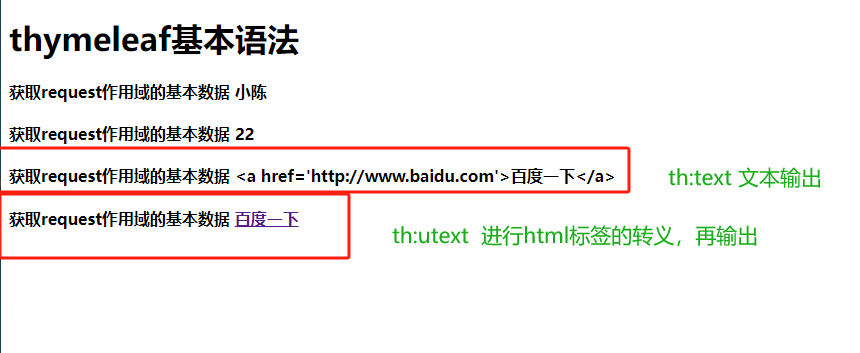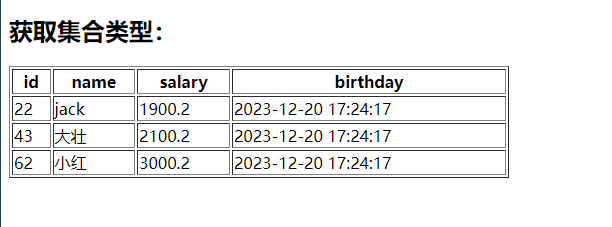Spring Boot学习随笔- 第一个Thymeleaf应用(基础语法th:,request、session作用域取值)
第十五章、Thymeleaf
Thymeleaf是一种现代化的服务器端Java模板引擎,专门用于Web和独立环境。Thymeleaf在有网络和无网络的环境下皆可运行,即可以让美工在浏览器查看页面的静态效果,也可以让程序员在服务器查看带数据的动态页面效果。它与Spring Boot集成良好,是Spring Boot官方支持的模板引擎之一。
-
比较其他模板引擎
目前主流模板引擎:Thymeleaf、FreeMarker、Groovy和Mustache
整体来说:FreeMarker在性能方面略有优势,但Thymeleaf在整体上胜出
注意:jsp可以直接在服务器访问,而Thymeleafa必须要经过控制器跳转访问
第一个Thymeleafaf网页
-
引入依赖
<dependency> <groupId>org.springframework.boot</groupId> <artifactId>**spring-boot-starter-thymeleaf**</artifactId> </dependency> -
配置thymeleaf模板配置
# THYMELEAF (ThymeleafAutoConfiguration) spring: thymeleaf: cache: false # 开启模板缓存(默认值: true ) 开发过程中改成false check-template: true # 检查模板是否存在,然后再呈现 check-template-location: true # 检查模板位置是否正确(默认值 :true ) servlet: content-type: text/html #Content-Type 的值(默认值: text/html ) enabled: true # 开启 MVC Thymeleaf 视图解析(默认值: true ) encoding: UTF-8 # 模板编码 excluded-view-names: # 要被排除在解析之外的视图名称列表,⽤逗号分隔 mode: HTML5 # 要运⽤于模板之上的模板模式。另⻅ StandardTemplate-ModeHandlers( 默认值: HTML5) prefix: # 在构建 URL 时添加到视图名称前的前缀(默认值: classpath:/templates/ ) suffix: # 在构建 URL 时添加到视图名称后的后缀(默认值: .html ) -
创建thymeleaf页面

-
开发Controller跳转thymeleaf
@Controller @RequestMapping("hello") public class HelloController { @RequestMapping("hello") public String hello() { System.out.println("hello thymeleaf "); return "index"; } }
Thymeleaf语法使用
-
html使用thymeleaf语法,必须引入命名空间
<html lang="en" xmlns:th="http://www.thymeleaf.org"> **th可以用于html标签的任意属性,非常方便,它允许在HTML、XML、JavaScript、CSS甚至纯文本中处理模板。th命名空间允许我们在HTML标签的任何属性中使用Thymeleaf表达式,这样我们可以将模型数据动态地绑定到HTML标签的属性中。** -
基本数据传递,
**th:text**属性取值@RequestMapping("demo") public String demo(HttpServletRequest request, Model model) { System.out.println("hello thymeleaf "); request.setAttribute("name", "小陈"); model.addAttribute("age", 22); return "demo"; } <!doctype html> <html lang="en" xmlns:th="http://www.thymeleaf.org"> <head> <meta charset="UTF-8"> <title>测试thymeleaf语法</title> </head> <body> <h1>thymeleaf基本语法</h1> thymeleaf取值的方式和jstl差不多,不过必须要在html标签里使用,通过${},括号 里面填入作用域存的属性名 <h4>获取request作用域的基本数据 <span **th:text="${name}"**></span></h4> <h4>获取request作用域的基本数据 <span **th:text="${age}"**></span></h4> </body> </html> -
th:utext属性**th:utext**会将文本内容作为原始HTML代码进行处理,不会进行HTML转义。这意味着如果后端传递的文本内容包含HTML标签,这些标签会被直接渲染为HTML元素,而不是作为纯文本显示。
-
直接在标签的value前面加上th前缀,也可以取值,例如:
<input type="text" name="name" **th:value="${name}"**>
-
-
获取对象类型
<h2>获取对象类型:</h2> <table border="1" width="500"> <tr> <th>id</th> <th>name</th> <th>salary</th> <th>birthday</th> </tr> <tr> <td th:text="${user.id}"></td> <td th:text="${user.name}"></td> <td th:text="${user.salary}"></td> <!--格式化日期--> <td th:text="${#dates.format(user.birthday,'yyyy-MM-dd HH:mm:ss')}"></td> </tr> </table> -
获取集合类型
通过th:each属性进行遍历,例如
**th:each="user:${users}"**<h2>获取集合类型:</h2> <!--遍历集合:th:each--> <table border="1" width="500"> <tr> <th>id</th> <th>name</th> <th>salary</th> <th>birthday</th> </tr> <tr **th:each="user:${users}"**> <td th:text="${user.id}"></td> <td th:text="${user.name}"></td> <td th:text="${user.salary}"></td> <!--格式化日期--> <td th:text="${#dates.format(user.birthday,'yyyy-MM-dd HH:mm:ss')}"></td> </tr> </table> 执行效果:成功获取

-
通过遍历状态获取信息
<tr th:each="user,state:${users}"> <td th:text="计数+${state.count}"></td> <td th:text="'判断偶数行:'+${state.odd}"></td> <td th:text="'判断奇数行:'+${state.even}"></td> <td th:text="'集合长度=:'+${state.size}"></td> <td th:text="${user.id}"></td> <td th:text="${user.name}"></td> <td th:text="${user.salary}"></td> <!--格式化日期--> <td th:text="${#dates.format(user.birthday,'yyyy-MM-dd HH:mm:ss')}"></td> </tr> 执行效果:

-
-
通过
th:if有条件展示数据<div th:if="${user.role == 'admin'}"> <p>您是管理员,拥有特殊权限。</p> </div> <div th:if="${user.role == 'manager'}"> <p>您是经理,可以管理团队。</p> </div> <div th:if="${user.role == 'employee'}"> <p>您是普通员工,完成日常工作。</p> </div> -
获取
session作用域数据,加上session前缀即可<h2>获取session作用域中数据:<span th:text="${session.name}"></span></h2> -
获取项目名地址
通过
th:href=”@{/demo.css}”的方式获取,常用于重定向跳转的时候访问不到css文件的时候,使用根目录路径<link rel="stylesheet" th:href="@{/demo.css}">
作者:扬眉剑出鞘
出处: https://www.cnblogs.com/eyewink/
本文版权归作者和博客园共有,欢迎转载,但未经作者同意必须保留此段声明,且在文章页面明显位置给出原文连接,否则保留追究法律责任的权利。





【推荐】国内首个AI IDE,深度理解中文开发场景,立即下载体验Trae
【推荐】编程新体验,更懂你的AI,立即体验豆包MarsCode编程助手
【推荐】抖音旗下AI助手豆包,你的智能百科全书,全免费不限次数
【推荐】轻量又高性能的 SSH 工具 IShell:AI 加持,快人一步
· 阿里最新开源QwQ-32B,效果媲美deepseek-r1满血版,部署成本又又又降低了!
· AI编程工具终极对决:字节Trae VS Cursor,谁才是开发者新宠?
· 开源Multi-agent AI智能体框架aevatar.ai,欢迎大家贡献代码
· Manus重磅发布:全球首款通用AI代理技术深度解析与实战指南
· 被坑几百块钱后,我竟然真的恢复了删除的微信聊天记录!